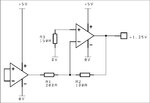d123
Advanced Member level 5

Hi,
Is there any reason not to short the input pins of an op amp? i.e. such as in the image:

Bandgaps have an unavoidable curve over temperature with 0ppm/ºC resistors from 0 - 100ºC, which can be compensated for to a great degree in different ways, and are basically "supply independent," the above image has no temperature curve with 10ppmºC resistors over the same range, but you could say it is highly supply dependent...
(although I think both designs are in fact supply dependent in different ways, bandgap for a known current source needed - itself to a degree dependent on a roughly known voltage source, and this for the precise known voltage source needed)
Is there some reason, or several, why the above circuit isn't typically used? Apart from there being no skill needed or joy in designing two op amps shoved together, whereas bandgaps look like a fine art?
Is there any reason not to short the input pins of an op amp? i.e. such as in the image:

Bandgaps have an unavoidable curve over temperature with 0ppm/ºC resistors from 0 - 100ºC, which can be compensated for to a great degree in different ways, and are basically "supply independent," the above image has no temperature curve with 10ppmºC resistors over the same range, but you could say it is highly supply dependent...
(although I think both designs are in fact supply dependent in different ways, bandgap for a known current source needed - itself to a degree dependent on a roughly known voltage source, and this for the precise known voltage source needed)
Is there some reason, or several, why the above circuit isn't typically used? Apart from there being no skill needed or joy in designing two op amps shoved together, whereas bandgaps look like a fine art?




